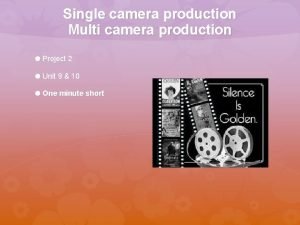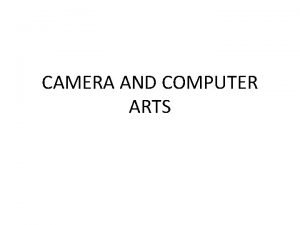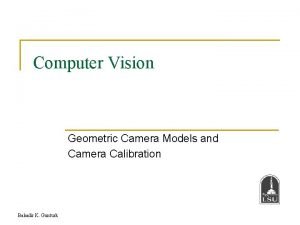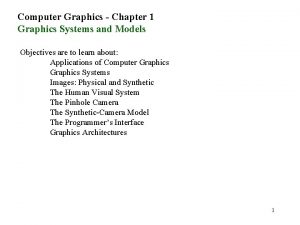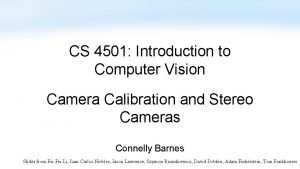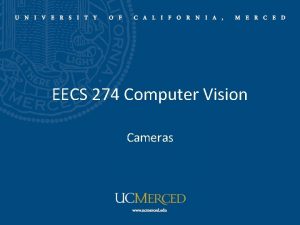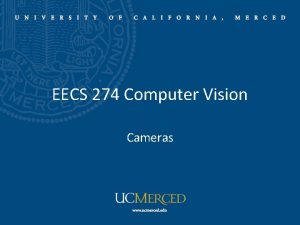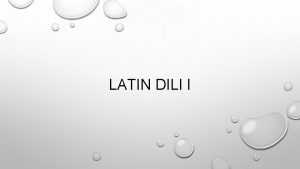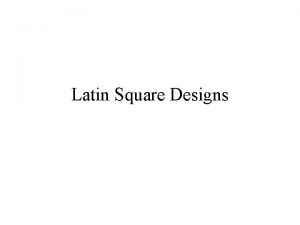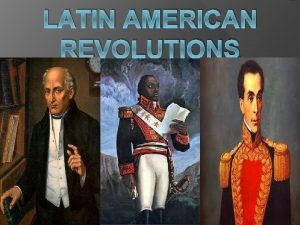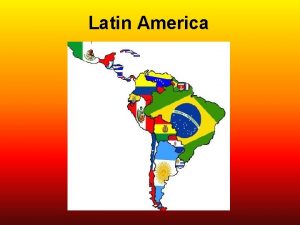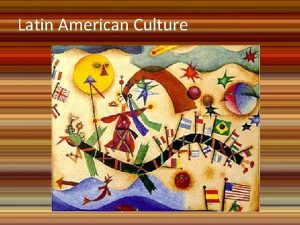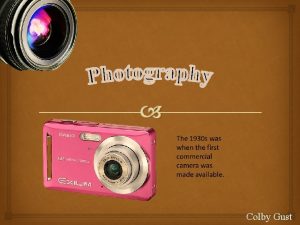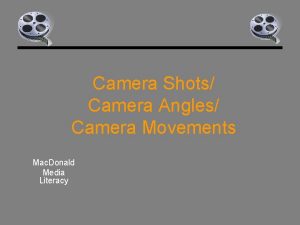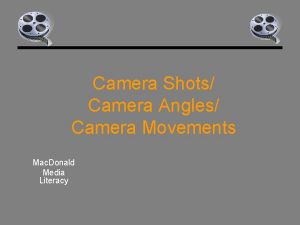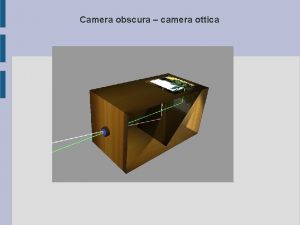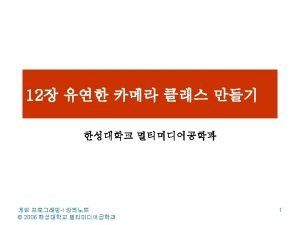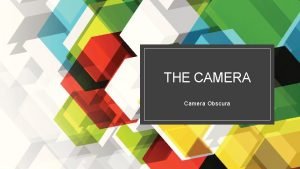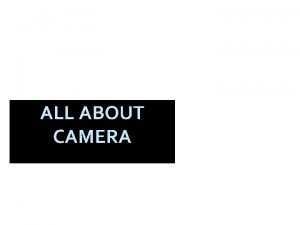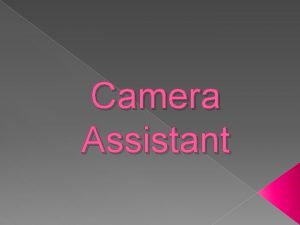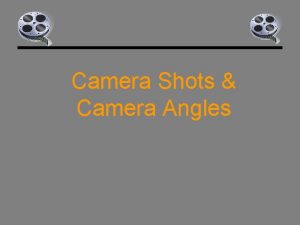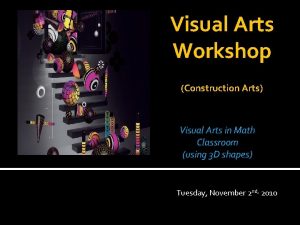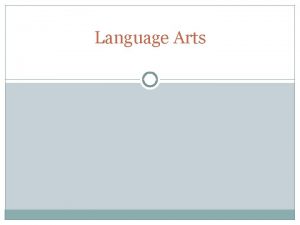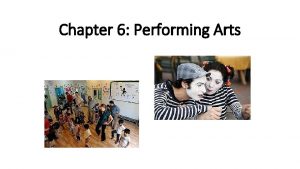CAMERA AND COMPUTER ARTS Camera is the Latin






































- Slides: 38

CAMERA AND COMPUTER ARTS

• Camera- is the Latin word for “ room. ” The camera relies on a natural observable fact, that light reflected from an object can, under controlled circumstances, project an image of the object onto a surface. • During the 16 th Century, a useful device was constructed to help capture the image transferring properties of light called the “Camera Obscura. ” • “A pinhole opening into a darkened chamber would form an exact view of the world outside, upside down. ” • The camera obscura was used during the renaissance to help the artist to reproduce the natural world as accurately as possible by tracing. • The computer, an electronic machine that could be programmed to process information in the form of data, was built around 1938. Photography is the art form that best demonstrates a basic truth “Artistry resides not in the hands but in the head. ” Difference: Painters, sculptors create forms. Photographers only find and record forms. • What is a camera? • A camera is a light tight box with an opening at one to adjust light, a lens to focus and refract the image and a light sensitive surface to receive the light image and hold it. •

Camera obscura, in cutaway view, 1646

Inventors of the Photographic Plates • French Inventor Joseph Nicephore Niepce used a specially coated pewter plate in the camera obscura to hold the image. He recorded an image from his studio after an exposure of 8 hrs. • Niepce called the images heliographs (sun writing), considered the first permanent photograph.

Joseph Nicéphore Niépce’s “View from the Window at Le Gras” 1822

Louis Jacques Mande Daguerre • Frenchman Louis Jacques Mande Daguerre in 1837 recorded an image in his studio using methods that could be duplicated. • He used a light sensitive surface copper plate coated with silver iodide calling it the daguerreotype. Using this method the exposure time was cut down to 10 to 20 min. • The negative aspect was the process produced a positive image- light & dark values were in as they appear to the eye. The plate became the photograph. • The early versions of producing a negative/positive printing process was the calotype that used a paper negative. • The collodian process was developed in the mid 19 th century that used a negative on glass.

Louis Jacques Mandé Daguerre, Le Boulevard du Temple, 1839

Subject Matter • • • Portraits Landscapes The Here and Now Photojournalism Photography and Art

Portraits were thing of the day or the-in thing! Carte de visite, French for visiting card- a photograph of yourself the size of a playing card.

Matthew Brady a well known photographer took photos of Abraham Lincoln was quoted as saying “Brady and the Cooper Union speech made me president”

Julia Margaret Cameron Henry Herschel Hay Cameron, Julia Margaret Cameron, 1870. Silver print, 9 1/4" x 8 1/2"

Julia Margaret Cameron Famous portraitist of the 19 th century Charles Darwin Henry Wadsworth Longfellow

Landscapes Timothy Sullivan was commissioned by the government to explore the territories of Colorado & Nevada

The Here and Now • 1888 George Eastman developed a camera called Kodak that changed photography forever. • The camera was light and handled. • The camera was sold with the slogan ”You press the button and we do the rest. ”

Richard Throssel, Crow Camp, 1910

Photojournalism Bearing Witness and Documenting • 1900 the first process for photomechanical reproduction high speed printing of photos and type was developed. • The Great Depression caused hardships for artists and photographers The farm Security Administration of the U. S. Department of Agriculture subsidized photographers sending them to document the conditions across the nation.

Dorthea Lange -traveled the whole country “Heading west, Tulane Lake, California”

Dorothea Lange, Migrant Mother, 1936

Liu Zheng, A Young Monk in Front of an Ancient Mural, 1996. From the series The . Gelatin silver print, 18" x 18" Chinese

Photography and Art Henry Peach Robinson’s “Fading Away, ” 1858

Alfred Stieglitz “for photography to be an art, it must be truth to its own nature, it should not try to be painting. ” • He wanted to make “pure” or straight photography. • Stieglitz was a pictorialist- a movement of photographers who used a variety of techniques to uncut the objectivity of the camera, producing gauzy, atmospheric images that seemed more painterly, more like art.

Alfred Stieglitz “The Steerage, ” 1907

The intent of the artist: Alfred Stieglitz Brazilian Sebastiao Salgado


Ansel Adams Autumn Tree Against Cathedral Rocks, Yosemite ca. 1944

Paul Strand. Abstraction. 1915.

Hannah Höch, Cut with the Kitchen Knife Dada through Germany’s Last Weimar Beer Belly Cultural Epoch, 1919. Collage, 44 7/8" x 35 1/8".

Man Ray, Champs délicieux, second rayogram, 1922. Rayogram, silver salt print, 8 1/4" x 7 1/2"

Cindy Sherman She uses photography to create images of herself as someone else.

Cindy Sherman, Untitled #123. 1983. Chromogenic color print, 35 x 24 1/2".

1990 Andres Serrano. Black Supper (II). .


Censorship • Censorship is” defined as the supervision by one individual or group over the artistic expression of another individual or group. • This definition assumes that person or group A has the power to control the expression of person or group B. • Usually, the power is exerted for political, religious, or moral reasons. • In other words, A can prevent B from making or showing work that conflicts with A’s political, religious, or moral point of view

The National Foundation on the Arts and Humanities Act passed 1965 • Declaration of purpose: ”it is necessary and appropriate for the Federal government to help create and sustain not only a climate encouraging freedom of thought, imagination and inquiry, but also the material conditions facilitating the release of this creative talent”

Robert Mapplethorpe American, 1946 -1989

Sally Mann, Untitled # 6, Antietam, 2001. Gelatin silver print, 38" x 48"

Andreas Gursky, Shanghai, 2000. C-print mounted on plexiglas in artist's frame, 9' 11" x 6' 9".

Thomas Ruff, Substratum 12 III, 2003. C-print and Diasec, 8' 4" x 5' 5 1/2".
 Creative arts grade 8 dance rubric
Creative arts grade 8 dance rubric Multi camera production
Multi camera production Camera moves
Camera moves Camera latin word
Camera latin word Why is called latin america
Why is called latin america Geometric camera models
Geometric camera models Synthetic camera model in computer graphics
Synthetic camera model in computer graphics Zed camera calibration
Zed camera calibration Camera models in computer vision
Camera models in computer vision Camera models in computer vision
Camera models in computer vision Hình ảnh bộ gõ cơ thể búng tay
Hình ảnh bộ gõ cơ thể búng tay Ng-html
Ng-html Bổ thể
Bổ thể Tỉ lệ cơ thể trẻ em
Tỉ lệ cơ thể trẻ em Voi kéo gỗ như thế nào
Voi kéo gỗ như thế nào Tư thế worm breton
Tư thế worm breton Bài hát chúa yêu trần thế alleluia
Bài hát chúa yêu trần thế alleluia Các môn thể thao bắt đầu bằng từ đua
Các môn thể thao bắt đầu bằng từ đua Thế nào là hệ số cao nhất
Thế nào là hệ số cao nhất Các châu lục và đại dương trên thế giới
Các châu lục và đại dương trên thế giới Công thức tính độ biến thiên đông lượng
Công thức tính độ biến thiên đông lượng Trời xanh đây là của chúng ta thể thơ
Trời xanh đây là của chúng ta thể thơ Mật thư anh em như thể tay chân
Mật thư anh em như thể tay chân Phép trừ bù
Phép trừ bù Phản ứng thế ankan
Phản ứng thế ankan Các châu lục và đại dương trên thế giới
Các châu lục và đại dương trên thế giới Thơ thất ngôn tứ tuyệt đường luật
Thơ thất ngôn tứ tuyệt đường luật Quá trình desamine hóa có thể tạo ra
Quá trình desamine hóa có thể tạo ra Một số thể thơ truyền thống
Một số thể thơ truyền thống Bàn tay mà dây bẩn
Bàn tay mà dây bẩn Vẽ hình chiếu vuông góc của vật thể sau
Vẽ hình chiếu vuông góc của vật thể sau Thế nào là sự mỏi cơ
Thế nào là sự mỏi cơ đặc điểm cơ thể của người tối cổ
đặc điểm cơ thể của người tối cổ V cc cc
V cc cc Vẽ hình chiếu đứng bằng cạnh của vật thể
Vẽ hình chiếu đứng bằng cạnh của vật thể Tia chieu sa te
Tia chieu sa te Thẻ vin
Thẻ vin đại từ thay thế
đại từ thay thế điện thế nghỉ
điện thế nghỉ


